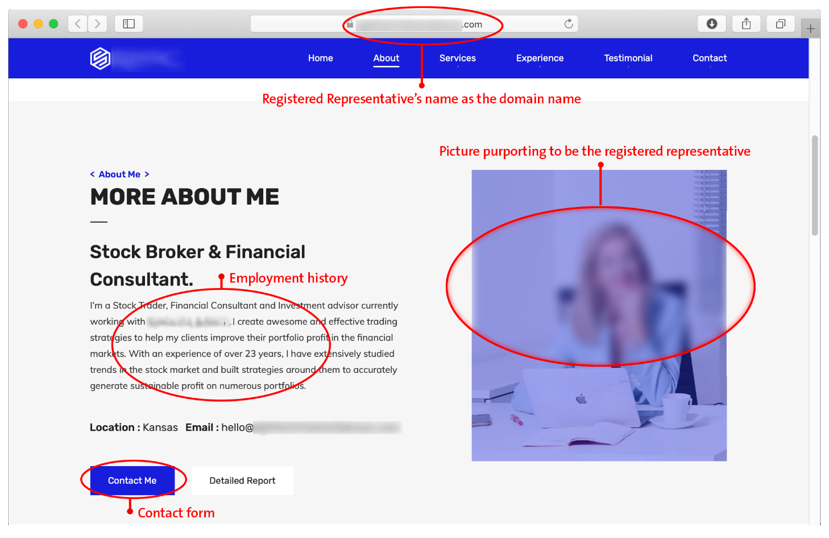Be Alert to Signs of Imposter Investment Scams

Imposter scams can take many forms, and there are new variants every day. In investment-related impersonation schemes, a common thread is that scammers misuse the name of real registered investment professionals or firms to create the appearance of legitimacy. Imposter schemes rely on a tactic known as source credibility—building trust by claiming to be properly registered and employed by a well-known firm—and they can be alarmingly convincing.
Sometimes these scams take off through social media promotion, such as incidents involving individuals portraying themselves as registered investment professionals and advertising access to “stock investment groups” on encrypted group chats like WhatsApp. In other types of scams, individuals might also pose as investors and create social media posts or leave comments detailing how much money they’ve made with a particular professional or strategy, with links leading to fraudulent websites or telephone numbers leading to WhatsApp. Some scammers offer fictitious securities investments, banking products or crypto asset trading strategies, which they tout as “can’t miss” opportunities.
Imposter scams can be difficult to spot unless you know what you’re looking for. Here are patterns to be aware of and tips to help spot the fakes.
Imposter Websites
Bad actors behind imposter websites often take the name and other publicly available details about a registered investment professional and use this information to establish a fraudulent website. The scammers then direct potential investors to the imposter sites. One goal is to obtain investors’ personal information or login credentials. In some cases, these bad actors will lure investors into making deposits into fake—but official-seeming—accounts in order to steal investor funds.

Imposter Documents
Another type of imposter scheme involves an unregistered individual using false registration documents to attract potential investors. In this instance, the scammer might create a fake version of a public FINRA BrokerCheck report for a legitimate investment professional, often with extensive experience and a spotless regulatory record. In most cases, the real professional isn’t aware their identity is being misused.
The scammer might then send the fake report to potential investors, using the name and registration number (known as a CRD number) of the registered investment professional but associating themselves with a company that isn’t registered as a broker-dealer with FINRA. The solicitation might include other documentation and a request for investors to respond with a photo of their driver’s license and other personal information.
Fraudulent Products
Imposter schemes might also involve fictitious products designed to closely resemble legitimate investments and respond to trends in the marketplace. For example, in times of volatility, investors might be drawn to investments offering lower but more stable returns.
Scammers might also take advantage of the evolving world of crypto assets to offer fraudulent investment opportunities or direct potential investors to websites that mimic legitimate crypto asset trading platforms while actually sending deposits directly to the scammer. These tactics are similar to those used in financial grooming scams, in which bad actors create a false sense of trust with a target for the sole purpose of eventually draining that person’s wallet.
To keep your money and personal information safe from these types of scams, take these six tips to heart.
1. Be alert to red flags of fraud. Guarantees, unregistered products, overly consistent or high returns, complex strategies, missing documentation, account discrepancies, secrecy and pushy salespeople are all cause for concern. Practice spotting persuasion tactics that scammers use, and always exercise healthy skepticism. Be particularly wary if you were solicited for an investment when you weren’t even looking for one.
2. Go to the source. Don’t assume that the information you receive from a supposed investment professional is legitimate. “Ask and check” before investing: Research both professionals and firms by going directly to the sources that collect regulatory information, including FINRA’s BrokerCheck and the SEC’s Investment Adviser Public Disclosure database, and contact your state regulator. Compare whatever documentation you received with the reports you obtain yourself, and take note of any inconsistencies, such as a slightly different firm name or location. You can also use these databases to verify whether the phone number or website provided to you match what’s listed in the firm’s Client Relationship Summary (Form CRS).
3. Verify contact information. See what comes up in a search online for the names of the individual and firm soliciting your business. Does it match the information provided to you, including the contact information? If something doesn’t look right, do a little more digging, including a map search on the address or a reverse lookup on the phone number. Call the financial institution using a phone number on their Form CRS or their public website—not the number that’s been provided in the suspect solicitation—to verify the legitimacy of the professional and the investment.
4. Look for things that appear out of place. Keep an eye out in any investment solicitation for typos, poor grammar, misspellings, odd or awkward phrasings, or misuse of investor terminology. Scammers might use URLs or email addresses that initially appear correct but on closer inspection reveal substituted characters, such as the numeral 1 in place of the letter l. And be on the lookout for websites using the registered representative’s name as the domain name for the website (e.g., firstnamemiddlenamelastname.com) or the use of different fonts within a document, which could indicate doctored information.
5. Confirm product legitimacy. Clarify the type of product you’re purchasing and type of financial institution you’re working with, since not all financial institutions are registered to sell all products. For example, only FINRA-registered broker-dealers can sell securities. If a website is offering only one type of investment, this should give you pause. Also exercise caution if an investment requires a high minimum deposit (such as $200,000 or more) or advertises such perks as higher-than-average interest rates, low or no risk, or FDIC insurance coverage. Investigate the product you’ve been offered, and see if the details align with what you’ve been given. If the investment is represented as a securities product, look up the CUSIP number, a unique identifier for legitimate securities.
6. Don’t send money, crypto or personal information. Be extra cautious if you’re asked to send information to a personal (rather than a firm’s) email address, to respond to phone numbers that aren’t listed as official firm contacts, or to send money directly to the individual or a third party. Don’t ever send money, crypto assets or personal information—such as your driver’s license, passport, Social Security number, date of birth, or bank account information—until you verify who you’re working with.
If you’re suspicious about information you receive from an individual or firm soliciting your business, contact FINRA or another regulator before you send any personal or financial information. If you’re an investment professional and have concerns that someone is using your name or information as part of a potential scam, contact your firm’s compliance department, and alert FINRA by calling the BrokerCheck hotline at (800) 289-9999 or emailing [email protected].





